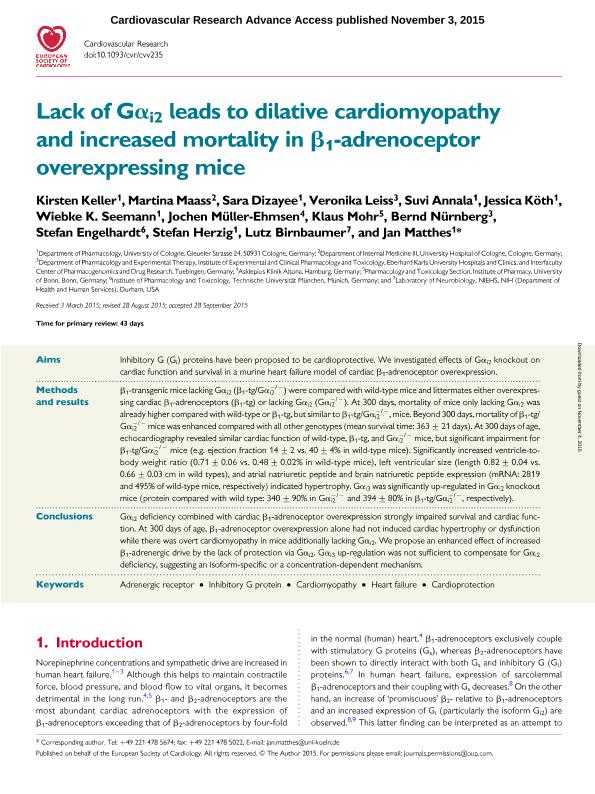Mostrar el registro sencillo del ítem
dc.contributor.author
Keller, Kirsten
dc.contributor.author
Maass, Martina
dc.contributor.author
Dizayee, Sara
dc.contributor.author
Leiss, Veronika
dc.contributor.author
Annala, Suvi
dc.contributor.author
Köth, Jessica
dc.contributor.author
Seemann, Wiebke K.
dc.contributor.author
Müller Ehmsen, Jochen
dc.contributor.author
Mohr, Klaus
dc.contributor.author
Nürnberg, Bernd
dc.contributor.author
Engelhardt, Stefan
dc.contributor.author
Herzig, Stefan
dc.contributor.author
Birnbaumer, Lutz

dc.contributor.author
Matthes, Jan
dc.date.available
2018-03-05T19:26:52Z
dc.date.issued
2015-12
dc.identifier.citation
Keller, Kirsten; Maass, Martina; Dizayee, Sara; Leiss, Veronika; Annala, Suvi; et al.; Lack of Gαi2 leads to dilative cardiomyopathy and increased mortality in β1-adrenoceptor overexpressing mice; Oxford University Press; Cardiovascular Research; 108; 3; 12-2015; 348-356
dc.identifier.issn
0008-6363
dc.identifier.uri
http://hdl.handle.net/11336/37874
dc.description.abstract
Aims Inhibitory G (Gi) proteins have been proposed to be cardioprotective. We investigated effects of Gαi2 knockout on cardiac function and survival in a murine heart failure model of cardiac β1-adrenoceptor overexpression. Methods and results β1-transgenic mice lacking Gαi2 (β1-tg/Gαi2 -/-) were compared with wild-type mice and littermates either overexpressing cardiac β1-adrenoceptors (β1-tg) or lacking Gαi2 (Gαi2 -/-). At 300 days, mortality of mice only lacking Gαi2 was already higher compared with wild-type or β1-tg, but similar to β1-tg/Gαi2 -/-, mice. Beyond 300 days, mortality of β1-tg/Gαi2 -/- mice was enhanced compared with all other genotypes (mean survival time: 363 ± 21 days). At 300 days of age, echocardiography revealed similar cardiac function of wild-type, β1-tg, and Gαi2 -/- mice, but significant impairment for β1-tg/Gαi2 -/- mice (e.g. ejection fraction 14 ± 2 vs. 40 ± 4% in wild-type mice). Significantly increased ventricle-to-body weight ratio (0.71 ± 0.06 vs. 0.48 ± 0.02% in wild-type mice), left ventricular size (length 0.82 ± 0.04 vs. 0.66 ± 0.03 cm in wild types), and atrial natriuretic peptide and brain natriuretic peptide expression (mRNA: 2819 and 495% of wild-type mice, respectively) indicated hypertrophy. Gαi3 was significantly up-regulated in Gαi2 knockout mice (protein compared with wild type: 340 ± 90% in Gαi2 -/- and 394 ± 80% in β1-tg/Gαi2 -/-, respectively). Conclusions Gαi2 deficiency combined with cardiac β1-adrenoceptor overexpression strongly impaired survival and cardiac function. At 300 days of age, β1-adrenoceptor overexpression alone had not induced cardiac hypertrophy or dysfunction while there was overt cardiomyopathy in mice additionally lacking Gαi2. We propose an enhanced effect of increased β1-adrenergic drive by the lack of protection via Gαi2. Gαi3 up-regulation was not sufficient to compensate for Gαi2 deficiency, suggesting an isoform-specific or a concentration-dependent mechanism.
dc.format
application/pdf
dc.language.iso
eng
dc.publisher
Oxford University Press

dc.rights
info:eu-repo/semantics/openAccess
dc.rights.uri
https://creativecommons.org/licenses/by-nc-sa/2.5/ar/
dc.subject
Adrenergic Receptor
dc.subject
Cardiomyopathy
dc.subject
Cardioprotection
dc.subject
Heart Failure
dc.subject
Inhibitory G Protein
dc.subject.classification
Inmunología

dc.subject.classification
Medicina Básica

dc.subject.classification
CIENCIAS MÉDICAS Y DE LA SALUD

dc.title
Lack of Gαi2 leads to dilative cardiomyopathy and increased mortality in β1-adrenoceptor overexpressing mice
dc.type
info:eu-repo/semantics/article
dc.type
info:ar-repo/semantics/artículo
dc.type
info:eu-repo/semantics/publishedVersion
dc.date.updated
2018-03-02T17:33:01Z
dc.journal.volume
108
dc.journal.number
3
dc.journal.pagination
348-356
dc.journal.pais
Reino Unido

dc.journal.ciudad
Oxford
dc.description.fil
Fil: Keller, Kirsten. Universitat Zu Köln; Alemania
dc.description.fil
Fil: Maass, Martina. University Hospital of Cologne; Alemania
dc.description.fil
Fil: Dizayee, Sara. Universitat Zu Köln; Alemania
dc.description.fil
Fil: Leiss, Veronika. Eberhard Karls University Hospitals and Clinics; Alemania
dc.description.fil
Fil: Annala, Suvi. Universitat Zu Köln; Alemania
dc.description.fil
Fil: Köth, Jessica. Universitat Zu Köln; Alemania
dc.description.fil
Fil: Seemann, Wiebke K.. Universitat Zu Köln; Alemania
dc.description.fil
Fil: Müller Ehmsen, Jochen. Asklepios Klinik Altona; Alemania
dc.description.fil
Fil: Mohr, Klaus. Universitaet Bonn; Alemania
dc.description.fil
Fil: Nürnberg, Bernd. Eberhard Karls University Hospitals and Clinics; Alemania
dc.description.fil
Fil: Engelhardt, Stefan. Universitat Technical Zu Munich; Alemania
dc.description.fil
Fil: Herzig, Stefan. Universitat Zu Köln; Alemania
dc.description.fil
Fil: Birnbaumer, Lutz. National Institutes of Health; Estados Unidos. Consejo Nacional de Investigaciones Científicas y Técnicas; Argentina
dc.description.fil
Fil: Matthes, Jan. Universitat Zu Köln; Alemania
dc.journal.title
Cardiovascular Research

dc.relation.alternativeid
info:eu-repo/semantics/altIdentifier/doi/http://dx.doi.org/10.1093/cvr/cvv235
dc.relation.alternativeid
info:eu-repo/semantics/altIdentifier/url/https://academic.oup.com/cardiovascres/article/108/3/348/557401
Archivos asociados
